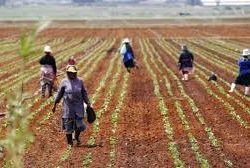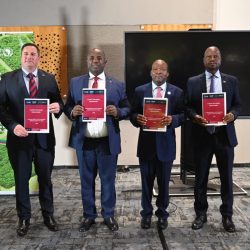Johannesburg— In a move signalling a renewed continental push for agricultural transformation, South Africa on Monday hosted the official launch of the Comprehensive Africa Agriculture Development Programme (CAADP) Strategy and Action Plan (2026–2035), alongside the ambitious Kampala Declaration. The gathering, a confluence of African leaders, agricultural experts, and development partners, has set the stage for a decade-long drive to reshape the continent’s farming landscape and rural economies.
The auspicious event, held in Johannesburg, saw the likes of Moses Vilakati, the AU Commissioner for Agriculture, Rural Development, Blue Economy, and Sustainable Environment, and Frank K. Tumwebaze, Uganda’s Minister of Agriculture, Animal Industry, and Fisheries and chair of the AU specialised technical committee on agriculture, grace the proceedings. Nardos Bekele-Thomas, CEO of AUDA-NEPAD, also lent her weight to the significant launch.
Leading the charge for South Africa, Agriculture Minister John Steenhuisen expressed palpable optimism about the future, declaring Johannesburg the “gateway into our continent.” He unequivocally pledged South Africa’s enduring political leadership and commitment to fostering agricultural growth and productivity across Africa, underscoring the nation’s pivotal role in this continental endeavour.
The CAADP Strategy and Action Plan (2026–2035), coupled with the Kampala Declaration, is poised to become a cornerstone of the African Union’s broader Agenda 2063—a comprehensive framework designed to steer the continent towards inclusive growth and sustainable development. Steenhuisen’s address highlighted the timely nature of these initiatives, arriving as Africa grapples with a myriad of pressing challenges, including sluggish economic growth, the shadow of geopolitical tensions, escalating food inflation, the looming threat of climate change, and the disruptive force of disease outbreaks.
While acknowledging the importance of global trade in national food security strategies, Steenhuisen offered a pragmatic caution against over-reliance on international markets, which could expose African nations to the vulnerabilities of supply chain disruptions. He underscored that the new CAADP plan offers invaluable insights into navigating these complex challenges, particularly for the continent’s ubiquitous smallholder farmers.
A dominant thread woven through the Minister’s address was the imperative of investment in Africa’s agricultural sector. Steenhuisen stressed that attracting both public and private capital is paramount in the fight against poverty, the reduction of hunger, and the vital boosting of agricultural productivity. Strengthening resource mobilisation and ensuring the efficient allocation of available resources were flagged as immediate priorities.
The minister also passionately articulated the crucial role of governments within the innovation ecosystem, not merely as funders of research and knowledge creation, but as ardent advocates for the widespread adoption of new technologies. “The agrifood system requires innovative technologies to adapt suitably to local social conditions,” Steenhuisen asserted, pointing to the persistent need to overcome market failures and government resource limitations that often impede progress.
The CAADP strategy demonstrates a keen understanding of the systemic challenges confronting the sector, including the degradation of vital water and land resources, the relentless pressure from pests and diseases, and the profound impact of climate change. Crucially, it also champions a data-driven approach to decision-making. Steenhuisen, however, did not shy away from addressing the ongoing challenge of data management, emphasising that robust evidence and reliable information are indispensable for enhancing agricultural performance and refining policy-making.
In consonance with the commitments outlined in Kampala, the strategy advocates for a multisectoral approach, one that seamlessly integrates agricultural and nutrition policies with the contemporary realities of rapid urbanisation, the burgeoning youth demographic, and evolving social dynamics. Steenhuisen acknowledged that tackling hunger and poverty in Africa’s slow-growing economies would necessitate coordinated efforts across a spectrum of sectors—from health and education to trade and infrastructure.
Looking ahead, the Minister urged for continuous assessment and accountability to ensure that Africa’s agricultural aspirations remain firmly rooted in reality. “We must thoroughly assess our progress across various sectors,” Steenhuisen concluded, underlining the urgent need for a practical and inclusive platform capable of attracting significant investment, with a particular focus on empowering women and youth in agriculture.




